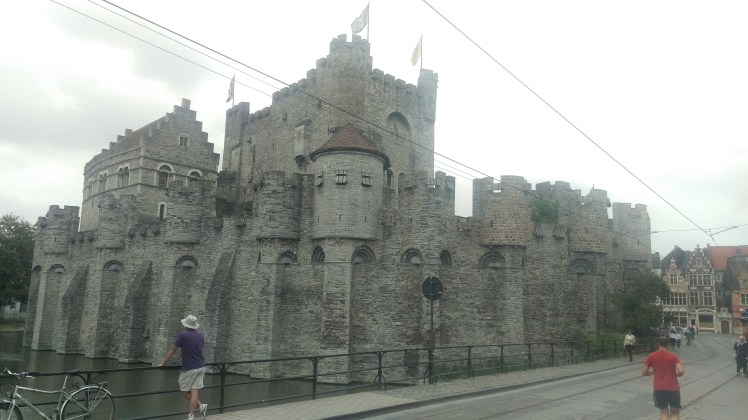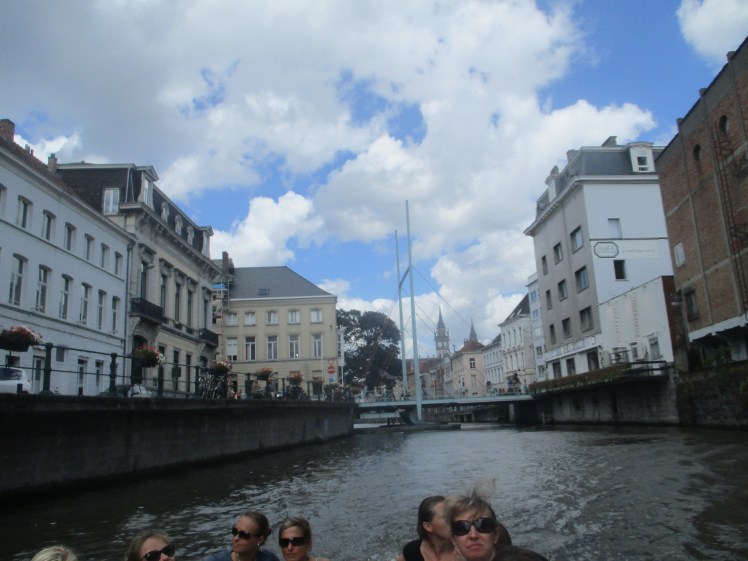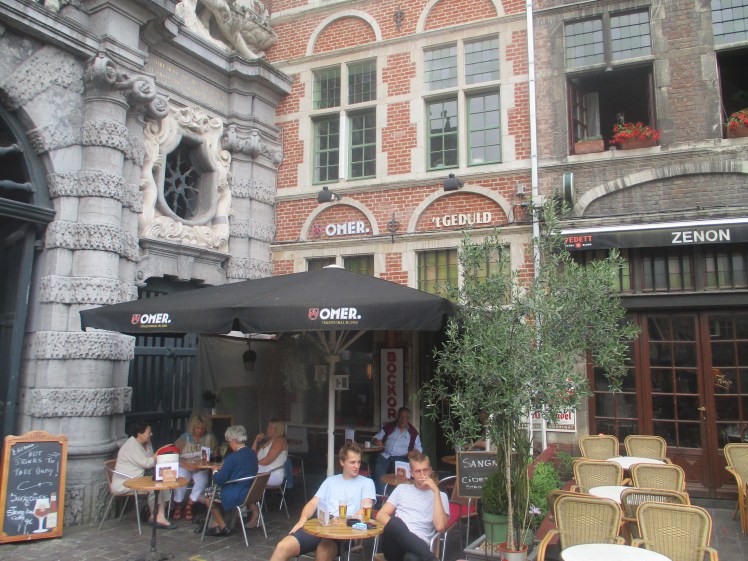
The original plan with my trip to Europe was to travel to Amsterdam, do what people tend to do when they are in Amsterdam, and then jump on a plane and fly to Istanbul to explore some of the coastal ruins, as well as paying a visit to Gallipolli (something that many Australians like to do, though it has been suggested that the one time you don’t go to Gallipolli is on ANZAC day because, well, the place becomes ridiculously crowded). Well, unfortunately, that didn’t happen, one of the reasons being that my Mum was dead against me taking my brother to Turkey (though she didn’t seem to have a problem with me taking him to Thailand and Cambodia – go figure).
Fortunately, I had a backup plan, taking into a account that I do tend to meticulously plan my trips beforehand (which was one of the benefits of having an incredibly boring job, or at least a job where I had some downtime). This backup plan was to, instead of heading to Turkey, catch a train and head down to Belgium. Well, as it turned out, there was a bit of time to kill when I was in Belgium, so for some reason I decided that once I had finished with Brussels (to the extent that I could finish with it, since there are still places there that I wish to check out, even if it is to just drink more Belgium beer) I would then head to Ghent. I’m not sure why, but in a way it was one of those places that seem to stick in my mind.
Well, one of the problems with distances between places in Europe being so small, is that it generally doesn’t take all that long to get there. Well, it does depend on where you happens to be, and the ability to get there. For example, the trek from Florence to Nice took us the entire day, and involved us catching three trains. Mind you, the trek actually look us through Cinque Terra, so it really isn’t something that I could complain about. Actually, our trek from Essen to Arnheim took almost as long, namely because the direct train has been cancelled, so we had to catch multiple other trains to get there.

That wasn’t really the problem when it came to traveling to Ghent though, namely because the trains were reasonably regular, and also we were in Brussels, so you can probably expect that you can pretty much get to most places in Belgium by train, if there happens to be a train going there. So, we jumped on our train, and before I could relax and open my book, we had pulled into the station at Ghent. Mind you, the station was actually pretty appalling, namely because there were no elevators or escalators, which meant that I had to lug mine, and my brother’s, luggage down into the subway and up the other side. Oh, and don’t even think of getting a coffee from the coffee shop here, because it is absolutely disgusting.

So, here we were, at eleven o’clock, in Ghent, so it was time to make our way to our hotel rooms, except the problem was that when we got there the rooms weren’t ready. Well, not quite, because I suspect they were ready, it is just that checkin doesn’t happen until about 2:00 pm, so we basically had to dump our bags and go for a wander around the town. Mind you, I have been to some places where they are pretty easy going when it comes to check in times – if there is a room there you get it. Mind you, when it involves big chain hotels, then they tend to be pretty strict. Okay, the Holiday Inn will make an offer to you for early checkin, but not surprisingly you have to pay. The other thing is that in Europe, checkout time is 12:00 pm, which means that you aren’t always rushing around in the morning – this isn’t the case with Australia, where it is a strict 10:00 am checkout.
Having left our bags at the hotel, it was time to go and explore the city, except that we caught the wrong tram which meant that we ended up in a part of the city which was definitely not a tourist haven. Mind you, I wouldn’t call it a bad place, namely because it was close enough to the city centre that we could jump off of the tram and walk there. Still, walking there did end up taking a little bit more time than expected, but soon enough we found ourselves where we wanted to be – the centre of town.

The thing with Ghent is that it is a university town, which means that alongside the tourists, there are also quite a few university students lounging around the area. The other thing is that you could say that Ghent is one of the cradles of Capitalism. This had a lot to do with the city being located on a major river, and also being quite close to the major ports of Antwerp. In fact, Ghent was the centre of a major textile industry, in that the raw materials would arrive from inland, and then be processed here before being shipped off all over Europe. To say that Ghent was a wealthy town was an understatement, though the Thirty Years War, and the rise of England and the Netherlands did end up bringing the city’s reign to an end.
The first thing we noticed as we rounded the corner to the banks of the Scheldt was that there were three huge spires thrusting up from the city centre. Two belonged to churches (St Nicholas and St Bartholemew), while the third belonged to the town hall, though I believe it is called the belfry. Well, considering that I do appreciate wandering through churches, I decided to go any check them out. Well, there were two churches, one of them being the Cathedral, and the other being a somewhat smaller church which was under repairs. Oh, there was also a third church (St Michaels) as well, but this one was closed to nosey tourists just wandering inside for a gander, at least until 2:00 pm. Mind you, this third church does have some claim to fame, namely because it dates back to the 14th Century.

Anyway, it was off to the Cathedral, and not only was it magnificent, but unfortunately you weren’t able to take photos inside. Then again, this cathedral does hold some pretty impressive works of art, including the Ghent Altarpiece. Mind you, when we were wandering around in the crypts (where the Altarpiece is stored) I saw it and though ‘wow, that is awesome’ but I didn’t actually acknowledge the significance of the item. However, when I went to the giftshop (yes, even churches have giftshops), because I couldn’t take any photos I decided to buy some postcards (which is probably the reason that you can’t take any photos inside).
The central part of Ghent is actually quite fascinating, since there are numerous places which reflect the glory days of the city, and its mercantile importance. For instance, there is a huge warehouse where the butchers used to operate out of, and just around the corner from this warehouse is one huge cannon – apparently the biggest cannon at the time. I would say that it was never fired in anger, but honestly, this is Europe, not Australia, so you can be assured that they attempted to use it.

I probably should mention the castle, Gravensteen, that happens to be located in the city as well. It isn’t a huge castle, in fact it is more a fort. The touristy aspect of the place is actually rather new, because since the Europeans stopped swarming across the continent declaring wars against each other, the fort had fallen into disuse. It was only recently that they decided to start restoring it, and then open it up to tourists. Prior to that the walls had basically been used to form the backs of a number of houses.
Another thing is that Amsterdam isn’t the only city that happens to be surrounded by canals, because Ghent also has a similar fame. Well, not to the extend of Amsterdam, but since Ghent stands at a section of the river where it splits in two, the early architects diverted to rivers to create a couple of large islands upon which the city was built. With Europe, where you happen to have cities on rivers, then you also have river cruises. However, the difference between the one in Amsterdam and the one here, was that sections of the river have been built over, so you find yourself traveling under houses and streets. The other thing was that a couple of centuries ago (about three, or four), the Scheldt was blocked to hinder the trade that Ghent was doing, and it has never been reopened, so unfortunately we were unable to travel all around the island.

So, I mentioned that this was a university town, and what do you tend to find in University towns – bars. Well, you pretty much find bars almost everywhere you go – people need a place to drink with friends, particularly when significant others don’t want you bringing all your friends back home with you (and considering the size of the houses in Europe, having all your mates come around for a few drinks can lead to a rather crowded affair). Not surprisingly, I decided to go and visit a few, namely by entering ‘best beer bars in Ghent’.
Well, the bars that popped up weren’t necessarily beer bars, but they were good (though the annoying thing is that by going over the city I suddenly realise there are bars that I haven’t visit, but since I was only there for two days, then it was going to be difficult to basically visit all of them). Anyway, one I visited, was called the Alchemist, and was just around the corner from Gravensteen. As I mentioned, the problem with great bars is that pretty much everybody wants to visit them, and that was the case here – it was packed.

The next bar wasn’t so much of a problem, though it was probably more a bottle shop that basically specialises in rare and exotic liqueurs. He did have some beer though, and some rather exotic ones at that. There was also a small balcony next to the river, though as it turned out, only two people could sit on it at a time. It was a bit of a shame, but then again it was pretty old, and I’m sure we really weren’t all that keen on ending up having a swim. Fortunately the couple that were on the balcony came inside, so we were able to go out onto it.
Then there is Cafe ‘t Geduld, which is pretty much in the same plaza that castle Gravensteen is located. Okay, I probably wouldn’t consider it and absolutely wonderful place, but since it is across from the castle, it is quite a handy place to go and grab a drink. Oh, and another one we visited was called Dulle Greit, which had one of those rather lovely medieval style interiors. Actually, it was probably more authentic than not, considering that this is Europe, and cities in Europe have been around for much longer than those in Australia.

Oh, they also have an Art Gallery, but then again pretty much every town of any reasonable size has an art gallery. Yet when we are dealing with places in Europe, once again, the art galleries tend to be larger (though the population of most cities also tend to be larger, to an extent – they tend to be more compact than those in Australia, and while only a handful of cities can be considered huge, there are a lot more cities scattered about the place), and the works of art not only older, but also much, much more impressive.
Well, that was my trip to Ghent, so the next morning it was back to that really, really annoying railway station to catch the train down to Lille.

Ghent is such a beautiful city!
LikeLike